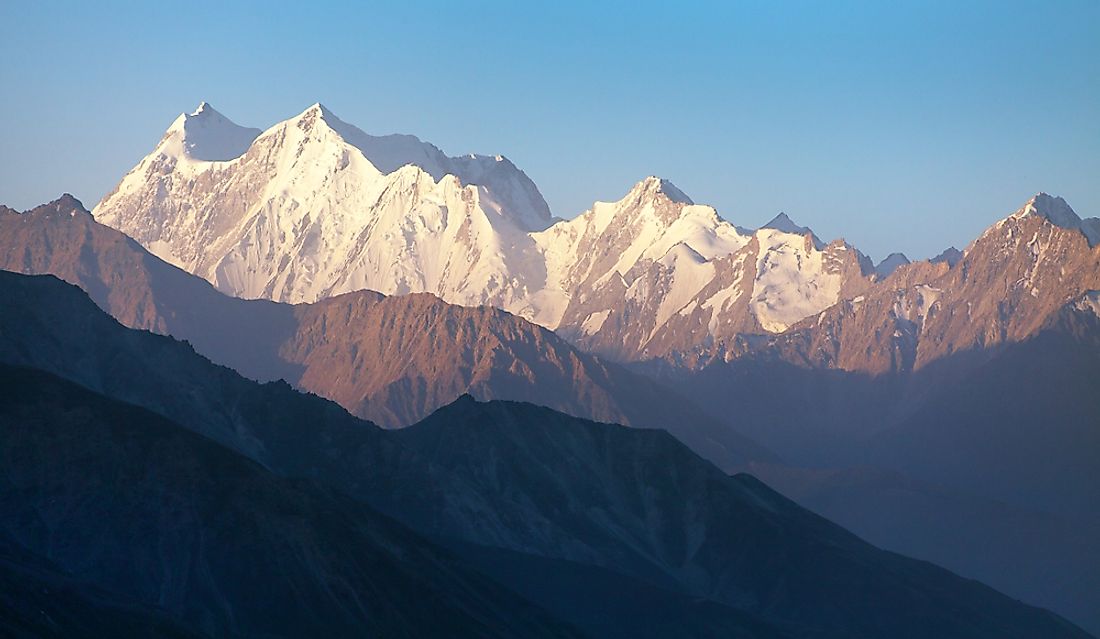The Tallest Mountains In Afghanistan

Afghanistan, officially referred to as the Islamic Republic of Afghanistan, is a landlocked country in Central Asia. The country borders China, Pakistan, Iran, Uzbekistan, Turkmenistan, and Tajikistan. Much of the country - around two-thirds - is mountainous, and a large part of the country is sparsely populated. The northern and the western part of the country have plains and valleys. The Afghani valleys are the most populated areas in the country, and most of the agriculture takes place in the region and the high plains. The climate in Afghanistan is arid to semi-arid and usually, experiences hot summer and cold winter. The highest point in the country is Noshaq with an elevation of 24,580 feet (7,492 meters) while the lowest point is Amu Darya with an elevation of 846 feet (258 meters).
Noshaq
Noshaq is in the second highest point in the whole of the Hindu Kush Ranges, and has an elevation of 24,580 feet (7,492 meters). The highest peak in the Kush range does not lie wholly in Afghanistan. Noshaq lies at the border between Pakistan and Afghanistan, the northern and western sides of the mountain lie in Afghanistan while the southern and the eastern parts of the mountain are in Pakistan. The first people to summit the mountain were two Japanese climbers named Toshiaki Sakai and Goro Iwatsubo who did so in 1960, while the first Afghani to climb the mountain achieved the feat in 2009.
Kohe Shakhawr is the second highest peak after Noshaq with an elevation of 23,346 feet, and it is also within the Kush Ranges. Shar Dhar is the third highest mountain in the Hindu Kush Mountains and has an elevation of 23,091 feet (7,038 meters). The mountain sits on the boundary between Pakistan and Afghanistan
Flora and Fauna in the Hindu Kush Mountains
Much of the tree cover in the middle mountains of the Hindu Kush are dominated by juniper and birch,while there are also large stands of blue pines and deodar ciders. Some of the cultivated plants include the mulberry, jujube, and walnut. Along the slopes, depending on their respective levels of shade exposure and sunny periods, are numerous pastures occasionally cultivated during the summertime by the local humans who migrate according the seasons. There is a wide variety of animal life well adapted to the mountains in the Hindus Kush, and they include the wild goats such as the Siberian ibex and the Markhor. There are also the wild sheep of the region, including the marco sheep and the urial. The black and brown bears are also found roaming the valleys and mountain sides. In the lower valleys are the snow leopard, vultures, and eagles.
Human development activities, especially irresponsible logging, poor farming techniques, and livestock overgrazing, have affected much of the region and have adversely affected the wildlife distribution. Still, there are efforts to foster wildlife preservation in areas that are not populated, and these have shown some success. In most of the Muslim and pagan religious sites, there are ibex horns indicating the importance of these wild goats among the communities living in the region.
Other Major Afghan Mountains and the Durand Line
Other exceptionally tall mountains in Afghanistan, and their respective heights in feet, include the Lunkho e Dosare (22,642), Kohe Hevad (22,470), Lugnuts-e-Barfi (22,398), Ku-e Bandaka(22,349), Gumbaza-e-Safed (22,310), and Koh-e Keshni Khan (22,162). The border between Pakistan and Afghanistan along the Hindus Kush mountain ranges is the Durand Line that has been the center of controversy and conflict between the two countries.The Durand Line is an erratic border line drawn by the British and the Afghan ruler in the 19th Century, and it has been inherited by the two countries.
Highest Mountains In Afghanistan
| Rank | Highest Mountains in Afghanistan | Elevation |
|---|---|---|
| 1 | Noshaq | 24,580 feet |
| 2 | Kohe Shakhawr | 23,346 feet |
| 3 | Shah Dahr | 23,091 feet |
| 4 | Kohe Urgunt | 23,018 feet |
| 5 | Lunkho e Dosare | 22,641 feet |
| 6 | Kohe Hevad | 22,470 feet |
| 7 | Languta-e-Barfi | 22,398 feet |
| 8 | Kuh-e Bandaka | 22,349 feet |
| 9 | Gumbaz-e-Safed | 22,310 feet |
| 10 | Koh-e Keshni Khan | 22,162 feet |







